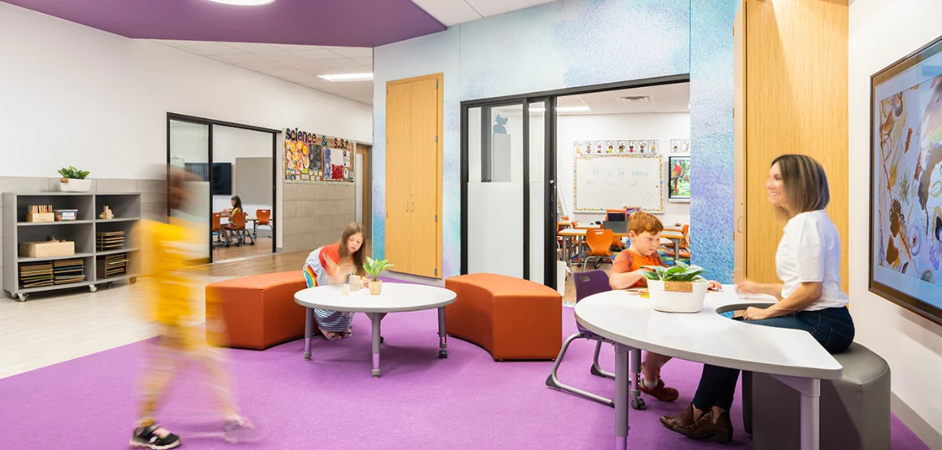Designing Inclusive Classrooms Where All Students Thrive

By Alicia Springer, M.Ed.
In this series from Artcobell, a leader in classroom furniture for 60 years, we review strategies for designing classrooms that are effective for all learners from the perspective of all stakeholders, including educators, designers, and therapists. The following has been adapted and condensed from the original article.
Thankfully, the “eyes-front-and-center” paradigm of education is fading fast. Educators like Alyssa Marshall, a former special education coordinator and the current assistant principal of Freedom Middle School in Spotsylvania, Virginia, are driving a new vision. Inclusive classroom design supports students with sensory processing disorder (SPD) as well as all learners. Early collaboration among teachers, administrators, and designers creates environments that benefit every student.
What Is Sensory Processing Disorder?
Sensory processing disorder is characterized by difficulties in processing sensory information. Challenges may appear as:
Over-responsivity: A child is highly reactive to sensory input.
Under-responsivity: A child may not respond to sensory input in expected ways.
SPD is often associated with autism or attention-deficit/hyperactivity disorder (ADHD), but many people with SPD have neither condition. SPD manifests differently for everyone, so flexible learning environments are key. “One key message I could offer for supporting those with SPD is to design for the whole student,” says Marshall.
Design Strategies That Support Every Learner
“We’re beginning to recognize that so-called ‘mainstream’ students often respond well to thoughtful accommodations that we once classified for SPD,” notes Patricia Cadigan, M. Ed., ALEP, chief development officer at Artcobell.
Schools are full of sensory challenges: bright lights, loud bells, crowded hallways, constant transitions. Inclusive classroom design reduces stress, improves focus, and creates environments where all students thrive.
Here are a few classroom design strategies that benefit students with SPD and the general student population:
Visual Schedules: Clear, dynamic displays help manage expectations and ease transitions.
Movement: Flexible seating and mobile work surfaces give students agency and balance movement with focus.
Targeted Lighting and Acoustics: Using light covers, natural lighting, and sound-dampening materials reduces overstimulation.
Exercise Infrastructure: Climbing features, swings, or active seating provide outlets for energy and improve classroom regulation.
These strategies embody principles of Universal Design for Learning, practices originally created to support special education that now serve as best practices for every student.

The Importance of Early Collaboration
Too often, schools address sensory needs reactively. Marshall and Cadigan stress that the best outcomes come when teachers, administrators, designers, therapists, and parents collaborate early in the planning process.
When stakeholders align during programming and design, they can:
Prioritize resources where they’ll have the most impact
Share insights from lived classroom experience
Reduce the need for costly retrofits later
Ensure that design solutions are proactive, not reactive
Building the Future of Inclusive Classrooms
Designing for an effective learning environment is not just about helping a specific group—it’s about rethinking the classroom as a whole. With thoughtful design, proactive planning, and collaboration across all stakeholders, schools can create inclusive, flexible environments that benefit every learner.
Stay tuned for Part 2 of this series, in which a physical therapist discusses collaborating with architecture and design firms to create classrooms informed by real-world experience.